Janet Roberts's Blog, page 12
August 12, 2014
Bath - Somerset
http://www.aboutnottinghamshire.co.uk
 As this was my first visit to the city I headed first to the Information Centre situation in the modern bus station. There they advised me to take a Bath City Sightseeing Tour, which started nearby, and somewhat to my surprise left every 10 minutes - these tours must be incredibly popular.
As this was my first visit to the city I headed first to the Information Centre situation in the modern bus station. There they advised me to take a Bath City Sightseeing Tour, which started nearby, and somewhat to my surprise left every 10 minutes - these tours must be incredibly popular.
There are two tours, and the ticket includes both rides, so I started with the Skyline Tour. One of the first stops (for photos) was to see the Pulteney Bridge. Completed in 1774 it was designed by Robert Adam in a Palladian style, and is one of only four bridges in the world with shops across its full span on both sides. Not surprisingly it.s a Grade I listed building.
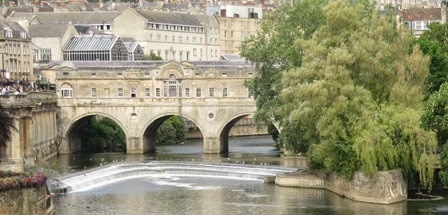 Then it was a steep climb up passed an early Toll House, and Prior Park, a National Trust Landscaped Garden. All these places I really fancied seeing, and as this was a 'hop on - hop off' bus that would have been possible, but unfortunately there was insufficient time, but it was a real encouragement to return to the city to explore it more thoroughly.
Then it was a steep climb up passed an early Toll House, and Prior Park, a National Trust Landscaped Garden. All these places I really fancied seeing, and as this was a 'hop on - hop off' bus that would have been possible, but unfortunately there was insufficient time, but it was a real encouragement to return to the city to explore it more thoroughly.
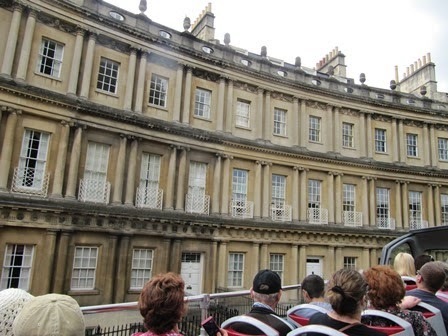 Once back in the city I had a welcome cuppa at Manvers Street church just opposite the bus stop, before climbing aboard once more for the City Tour, which was even more fascinating, as we wove our way around narrow streets, steep hills, and always near the soft golden architecture of the attractive buildings. Of course it would have been wonderful to have seen the famous Royal Crescent, but that is now closed to traffice, although it would have only been a short walk and a chance to visit No 1. But we did see another crescent, and were greeted by these customed figutes!
Once back in the city I had a welcome cuppa at Manvers Street church just opposite the bus stop, before climbing aboard once more for the City Tour, which was even more fascinating, as we wove our way around narrow streets, steep hills, and always near the soft golden architecture of the attractive buildings. Of course it would have been wonderful to have seen the famous Royal Crescent, but that is now closed to traffice, although it would have only been a short walk and a chance to visit No 1. But we did see another crescent, and were greeted by these customed figutes!
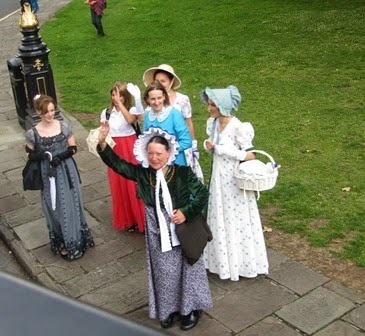
Eventually I alighted at the wonderful Bath Abbey, built in 1499, and had time to have a quick look round.
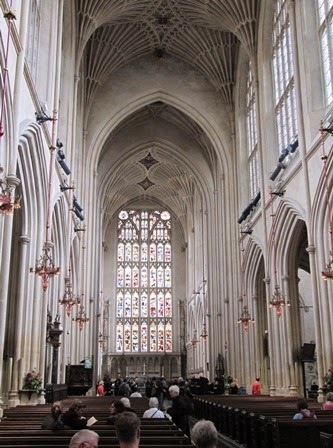
What a tempting, enjoyable time it had been, with so much to see and discover - taster was the true word for these bus tours. I couldn't think of anything more lovely than sitting at the very front on the top deck on the bus, listerning to the excellent commentary through the little earphones, and seeing the sights - although it must be a somewhat different experience in the rain!
Now I just can't wait to go and visit Bath again - next time for much longer!
***
If you enjoy my writing why not click here

 As this was my first visit to the city I headed first to the Information Centre situation in the modern bus station. There they advised me to take a Bath City Sightseeing Tour, which started nearby, and somewhat to my surprise left every 10 minutes - these tours must be incredibly popular.
As this was my first visit to the city I headed first to the Information Centre situation in the modern bus station. There they advised me to take a Bath City Sightseeing Tour, which started nearby, and somewhat to my surprise left every 10 minutes - these tours must be incredibly popular.There are two tours, and the ticket includes both rides, so I started with the Skyline Tour. One of the first stops (for photos) was to see the Pulteney Bridge. Completed in 1774 it was designed by Robert Adam in a Palladian style, and is one of only four bridges in the world with shops across its full span on both sides. Not surprisingly it.s a Grade I listed building.
 Then it was a steep climb up passed an early Toll House, and Prior Park, a National Trust Landscaped Garden. All these places I really fancied seeing, and as this was a 'hop on - hop off' bus that would have been possible, but unfortunately there was insufficient time, but it was a real encouragement to return to the city to explore it more thoroughly.
Then it was a steep climb up passed an early Toll House, and Prior Park, a National Trust Landscaped Garden. All these places I really fancied seeing, and as this was a 'hop on - hop off' bus that would have been possible, but unfortunately there was insufficient time, but it was a real encouragement to return to the city to explore it more thoroughly. Once back in the city I had a welcome cuppa at Manvers Street church just opposite the bus stop, before climbing aboard once more for the City Tour, which was even more fascinating, as we wove our way around narrow streets, steep hills, and always near the soft golden architecture of the attractive buildings. Of course it would have been wonderful to have seen the famous Royal Crescent, but that is now closed to traffice, although it would have only been a short walk and a chance to visit No 1. But we did see another crescent, and were greeted by these customed figutes!
Once back in the city I had a welcome cuppa at Manvers Street church just opposite the bus stop, before climbing aboard once more for the City Tour, which was even more fascinating, as we wove our way around narrow streets, steep hills, and always near the soft golden architecture of the attractive buildings. Of course it would have been wonderful to have seen the famous Royal Crescent, but that is now closed to traffice, although it would have only been a short walk and a chance to visit No 1. But we did see another crescent, and were greeted by these customed figutes!
Eventually I alighted at the wonderful Bath Abbey, built in 1499, and had time to have a quick look round.

What a tempting, enjoyable time it had been, with so much to see and discover - taster was the true word for these bus tours. I couldn't think of anything more lovely than sitting at the very front on the top deck on the bus, listerning to the excellent commentary through the little earphones, and seeing the sights - although it must be a somewhat different experience in the rain!
Now I just can't wait to go and visit Bath again - next time for much longer!
***
If you enjoy my writing why not click here

Published on August 12, 2014 22:44
August 10, 2014
International Balloon Fiesta - Bristol - Somerset
http://www.aboutnottinghamshire.co.uk/
This amazing event is held every year, having been started in 1979, and is now one of the largest such events in Europe. I just couldn't believe that I had only just heard about it, and couldn't wait to travel down to Bristol to see it for myself! (Apparently in 2003 the weight of crowds returning from the Balloon Fiesta put such a strain on the Clifton Suspension Bridge that since then the bridge has been closed during the event!)
 The lift-off was timed for 6pm, but actually at that time on Friday night not a lot seemed to be happening, although the very clear sound system did keep up informed that weather conditions were being studied carefully to ensure perfect safety for those flying. Then, quite suddenly the arena was full of lumps as the balloons became inflated!
The lift-off was timed for 6pm, but actually at that time on Friday night not a lot seemed to be happening, although the very clear sound system did keep up informed that weather conditions were being studied carefully to ensure perfect safety for those flying. Then, quite suddenly the arena was full of lumps as the balloons became inflated!
Then, quite suddenly, to a great cheer from the waiting thousands, the first balloon took off, which was really exciting

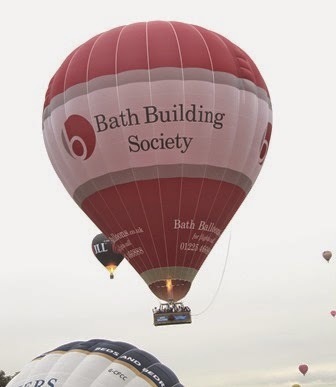 Then there was no stopping them! All over the arena balloons inflated, passengers climbed into flimsy baskets, and they were up and away, to the delight of the crowds.
Then there was no stopping them! All over the arena balloons inflated, passengers climbed into flimsy baskets, and they were up and away, to the delight of the crowds.
Soon the air was full of floating balloons, occasionally enhanced by the flare of the burner - it was really an incredible sight

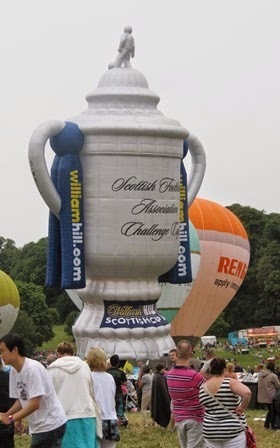 It was sad to see them drift away, but then giant inflatables appeared, in such funny, amusing shapes!
It was sad to see them drift away, but then giant inflatables appeared, in such funny, amusing shapes!
I thought this was an incredible experience, and I was really glad I'd made the journey from Nottinghamshire especially to see it, although there were a few things I would have altered. Like it would have been nice if there had been some sort of transportation from the official bus to the arena, as it was a very long, uphill walk, especially for the less able-bodied. Also I would have liked it if there had been Guides, like the friendly volunteers at the Olympic Games, who were on hand to help first-timers like me! I hadn't a clue where to go on the huge site, and the one sign I found didn't have the magic words 'You are here'! They could also have sold programmes. I would have liked one of these, as I'd seen a couple of people crossing off the balloons from illustrations in what I presumed was a programme, but I never found where they were for sale, which was a real pity.
Also I would have appreciated tables and SEATS - there was absolutely nothing, and sitting on the grass for hours, or standing around, is not for everyone.
****PS If you enjoy my writing why not click here

This amazing event is held every year, having been started in 1979, and is now one of the largest such events in Europe. I just couldn't believe that I had only just heard about it, and couldn't wait to travel down to Bristol to see it for myself! (Apparently in 2003 the weight of crowds returning from the Balloon Fiesta put such a strain on the Clifton Suspension Bridge that since then the bridge has been closed during the event!)
 The lift-off was timed for 6pm, but actually at that time on Friday night not a lot seemed to be happening, although the very clear sound system did keep up informed that weather conditions were being studied carefully to ensure perfect safety for those flying. Then, quite suddenly the arena was full of lumps as the balloons became inflated!
The lift-off was timed for 6pm, but actually at that time on Friday night not a lot seemed to be happening, although the very clear sound system did keep up informed that weather conditions were being studied carefully to ensure perfect safety for those flying. Then, quite suddenly the arena was full of lumps as the balloons became inflated!Then, quite suddenly, to a great cheer from the waiting thousands, the first balloon took off, which was really exciting

 Then there was no stopping them! All over the arena balloons inflated, passengers climbed into flimsy baskets, and they were up and away, to the delight of the crowds.
Then there was no stopping them! All over the arena balloons inflated, passengers climbed into flimsy baskets, and they were up and away, to the delight of the crowds.Soon the air was full of floating balloons, occasionally enhanced by the flare of the burner - it was really an incredible sight

 It was sad to see them drift away, but then giant inflatables appeared, in such funny, amusing shapes!
It was sad to see them drift away, but then giant inflatables appeared, in such funny, amusing shapes!I thought this was an incredible experience, and I was really glad I'd made the journey from Nottinghamshire especially to see it, although there were a few things I would have altered. Like it would have been nice if there had been some sort of transportation from the official bus to the arena, as it was a very long, uphill walk, especially for the less able-bodied. Also I would have liked it if there had been Guides, like the friendly volunteers at the Olympic Games, who were on hand to help first-timers like me! I hadn't a clue where to go on the huge site, and the one sign I found didn't have the magic words 'You are here'! They could also have sold programmes. I would have liked one of these, as I'd seen a couple of people crossing off the balloons from illustrations in what I presumed was a programme, but I never found where they were for sale, which was a real pity.
Also I would have appreciated tables and SEATS - there was absolutely nothing, and sitting on the grass for hours, or standing around, is not for everyone.
****PS If you enjoy my writing why not click here

Published on August 10, 2014 03:57
August 7, 2014
Ferry across the Mersey - Liverpool
http://www.aboutnottinghamshire.co.uk/
People have been using boats to get across the Mersey river at this point since at least the 12th century, and now there are 3 vessels, all managed by Merseytravel. Certainly it is known that in 1150 monks from Benedictine Priory at Birkenhead used to charge a small fare to row passengers across the river. When the weather was really bad passengers would take shelter in the priory.
In 1330 King Edward III granted a charter to the Priory and its successors for ever giving them 'the right of ferry there... for men, horses and goods, with leave to charge reasonable tolls.' This would have continued but for the Priory's destruction during the Dissolution of the Monasteries by Henry VIII in 1536. Private owners stepped in to man the crossing, now using fully rigged sailing ships, which must have looked spectacular, but were even more dependent on suitable weather.
The first steamship was a wooden paddle boat introduced in 1815 which operated between Liverpool and Runcorn. In 1886 the Mersey railway came into operation, with the ferries being the only means of crossing the river, so was heavily used, although at this time the Mersey Railway Tunnel opened, which for the first time brought competition for the ferry service.
In 1914 King George and Queen Mary travelled on the ferry from Wallasey to Liverpool. During the First World War two of the ferries were used as troop ships, their shallow draft allowing them to skim over the mines flaoting beneath the surface. Afterward their work was rewarded by being granted the honour of using the word 'Royal' in their name.
 When I was recently in Liverpool for the return of the Giant puppets (see previous blog)I couldn't wait to travel on this famous ferry, and I certainly wasn't disappointed.
When I was recently in Liverpool for the return of the Giant puppets (see previous blog)I couldn't wait to travel on this famous ferry, and I certainly wasn't disappointed.
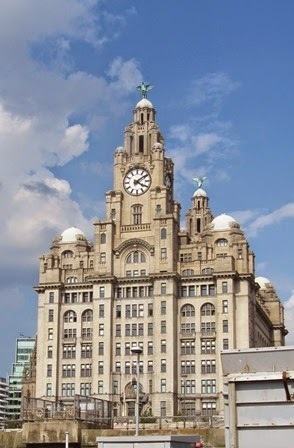 The views of lovely buildings along the banks on the Liverpool side is just spectacular. I loved the Royal Liver Building, opened in 1911 and now a Grade 1 listed building, it is one of the first buildings in the world to be built using reinforced concrete.
The views of lovely buildings along the banks on the Liverpool side is just spectacular. I loved the Royal Liver Building, opened in 1911 and now a Grade 1 listed building, it is one of the first buildings in the world to be built using reinforced concrete.
Then there is the equally magnificient Cunard Building, listed Grade II* and was incredibly constructed during the First World War.
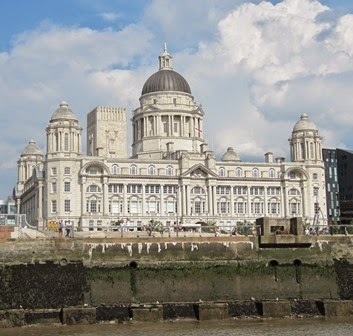
I managed to make two trips on the ferry during my brief stay in Liverpool, and it was just such a grand experience I could well see why it was so popular. Not an experience to be missed.
****
If you enjoy my blog, why not click here

People have been using boats to get across the Mersey river at this point since at least the 12th century, and now there are 3 vessels, all managed by Merseytravel. Certainly it is known that in 1150 monks from Benedictine Priory at Birkenhead used to charge a small fare to row passengers across the river. When the weather was really bad passengers would take shelter in the priory.
In 1330 King Edward III granted a charter to the Priory and its successors for ever giving them 'the right of ferry there... for men, horses and goods, with leave to charge reasonable tolls.' This would have continued but for the Priory's destruction during the Dissolution of the Monasteries by Henry VIII in 1536. Private owners stepped in to man the crossing, now using fully rigged sailing ships, which must have looked spectacular, but were even more dependent on suitable weather.
The first steamship was a wooden paddle boat introduced in 1815 which operated between Liverpool and Runcorn. In 1886 the Mersey railway came into operation, with the ferries being the only means of crossing the river, so was heavily used, although at this time the Mersey Railway Tunnel opened, which for the first time brought competition for the ferry service.
In 1914 King George and Queen Mary travelled on the ferry from Wallasey to Liverpool. During the First World War two of the ferries were used as troop ships, their shallow draft allowing them to skim over the mines flaoting beneath the surface. Afterward their work was rewarded by being granted the honour of using the word 'Royal' in their name.
 When I was recently in Liverpool for the return of the Giant puppets (see previous blog)I couldn't wait to travel on this famous ferry, and I certainly wasn't disappointed.
When I was recently in Liverpool for the return of the Giant puppets (see previous blog)I couldn't wait to travel on this famous ferry, and I certainly wasn't disappointed. The views of lovely buildings along the banks on the Liverpool side is just spectacular. I loved the Royal Liver Building, opened in 1911 and now a Grade 1 listed building, it is one of the first buildings in the world to be built using reinforced concrete.
The views of lovely buildings along the banks on the Liverpool side is just spectacular. I loved the Royal Liver Building, opened in 1911 and now a Grade 1 listed building, it is one of the first buildings in the world to be built using reinforced concrete.Then there is the equally magnificient Cunard Building, listed Grade II* and was incredibly constructed during the First World War.

I managed to make two trips on the ferry during my brief stay in Liverpool, and it was just such a grand experience I could well see why it was so popular. Not an experience to be missed.
****
If you enjoy my blog, why not click here

Published on August 07, 2014 06:51
July 29, 2014
The Giants Return - Liverpool
http://www.aboutnottinghamshire.co.uk/
I was fortunate enough to see these amazing giant puppets the last time they were in Liverpool (see previous blog)and when I heard they were returning - well I just had to be there!
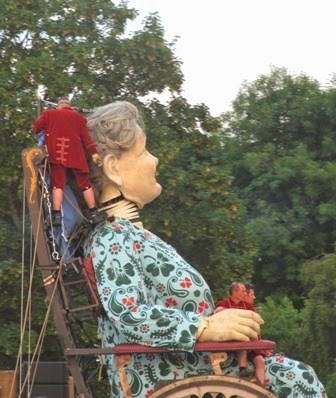 On Friday night I joined thousands of people to see the Giants arrive in Newsham Park. The first thing that strikes you is the sheer size - here full grown staff members sit comfortably on the Grandmother's lap!
On Friday night I joined thousands of people to see the Giants arrive in Newsham Park. The first thing that strikes you is the sheer size - here full grown staff members sit comfortably on the Grandmother's lap!

As before the Girl was accompanied by her faithful dog Xolo, who proved very difficult to photograph as he charged about with great enthusiasm! I was thankful when he settled down to sleep!
On the Sunday I went down to The Strand as the Giants made their final walk through the city before sailing off down the Mersey
What a marvellous, fun event - I was so pleased I was there! ***If you like my writing why not click here
I was fortunate enough to see these amazing giant puppets the last time they were in Liverpool (see previous blog)and when I heard they were returning - well I just had to be there!
 On Friday night I joined thousands of people to see the Giants arrive in Newsham Park. The first thing that strikes you is the sheer size - here full grown staff members sit comfortably on the Grandmother's lap!
On Friday night I joined thousands of people to see the Giants arrive in Newsham Park. The first thing that strikes you is the sheer size - here full grown staff members sit comfortably on the Grandmother's lap!
As before the Girl was accompanied by her faithful dog Xolo, who proved very difficult to photograph as he charged about with great enthusiasm! I was thankful when he settled down to sleep!
On the Sunday I went down to The Strand as the Giants made their final walk through the city before sailing off down the Mersey
What a marvellous, fun event - I was so pleased I was there! ***If you like my writing why not click here
Published on July 29, 2014 02:49
July 18, 2014
Henri Matisse - The Cut-Outs- exhibition - London
http://www.aboutnottinghamshire.co.uk/
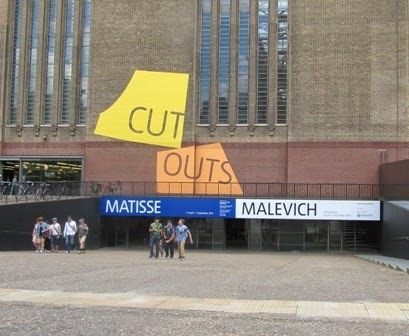 This exhibition was described in the press as a groundbreaking reassessment of Matisse's colourful and innovative final works. It claimed to be the most comprehensive exhibition ever devoted entirely to the artist's paper cut-outs. Definitely a 'must see' I thought!
This exhibition was described in the press as a groundbreaking reassessment of Matisse's colourful and innovative final works. It claimed to be the most comprehensive exhibition ever devoted entirely to the artist's paper cut-outs. Definitely a 'must see' I thought!
Held in the amazing Tate Modern on the south bank of the River Thames in London the first thing that struck me was the vastness of the space within the entrance hall. Originally this building had been the Bankside Power Station, but was converted in 1994, yet still retains much of its industrial feel.
 The Matisse exhibition was up the escalator, and pre-booking was advised. Immediately I was handed an informative booklet, and the chance to rent an audio guide, which proved to be absolutely excellent and very informative.
The Matisse exhibition was up the escalator, and pre-booking was advised. Immediately I was handed an informative booklet, and the chance to rent an audio guide, which proved to be absolutely excellent and very informative.
It was fascinating to learn that despite increasing ill-health and old age, Matisse enthusiastically embraced this new way of creating art works, and it was so good to see videos of him actually working and shaping and cutting paper, with such speed and flowing movement. I could have stood and watched all day!
What I loved was the sheer joy that was so evident in his work, as well as the size, for many of these cut-outs covered whole walls of his home. Who could not be thrilled by the sight of the leaping figure, and the parakeet nestled amongst his seaweed-like shapes? It was amazing to realize that at the time Matisse was too frail to leave his house, and this was his way of bringing the garden indoors. By now he had established a regular way of working. His devoted assistants painted the paper in the gouache colours of his choice, and then - with pin-cushions strapped to their wrists, and hammers round their necks, they would climb up ladders to position the cut-out shapes where the artist wanted them. It has since been found that some of the designs have hundreds of pin holes where the paper was moved around until he was completely satisfied with the composition.
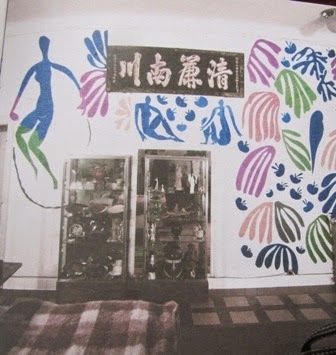
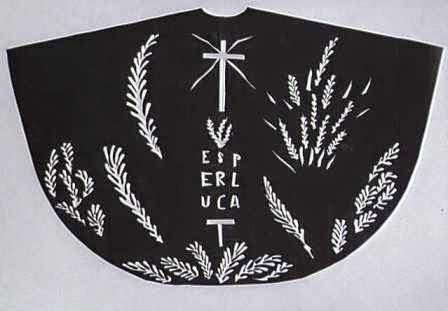 Something I didn't know was that in 1947, when he was in his late 70's, he was asked to design a stained glass window for the Dominican Chapel of the Rosary in Venice. He became so enthusiastic that he took on the total design project, even including this striking chasuble robe to be worn by the priest.
Something I didn't know was that in 1947, when he was in his late 70's, he was asked to design a stained glass window for the Dominican Chapel of the Rosary in Venice. He became so enthusiastic that he took on the total design project, even including this striking chasuble robe to be worn by the priest.
Of course there were the familiar Blue Nudes, brought together of the first time, and lovely, dancing Icarus - who could not love this figure!
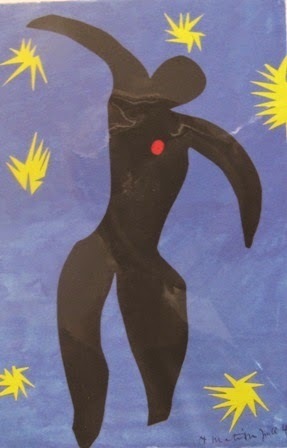
I loved this exhibition and learn so much about Matisse that I didn't know before, and certainly appreciated all the thought and effort that had gone into creating something so outstanding. ***If you enjoy my writing why not click here?
 This exhibition was described in the press as a groundbreaking reassessment of Matisse's colourful and innovative final works. It claimed to be the most comprehensive exhibition ever devoted entirely to the artist's paper cut-outs. Definitely a 'must see' I thought!
This exhibition was described in the press as a groundbreaking reassessment of Matisse's colourful and innovative final works. It claimed to be the most comprehensive exhibition ever devoted entirely to the artist's paper cut-outs. Definitely a 'must see' I thought!Held in the amazing Tate Modern on the south bank of the River Thames in London the first thing that struck me was the vastness of the space within the entrance hall. Originally this building had been the Bankside Power Station, but was converted in 1994, yet still retains much of its industrial feel.
 The Matisse exhibition was up the escalator, and pre-booking was advised. Immediately I was handed an informative booklet, and the chance to rent an audio guide, which proved to be absolutely excellent and very informative.
The Matisse exhibition was up the escalator, and pre-booking was advised. Immediately I was handed an informative booklet, and the chance to rent an audio guide, which proved to be absolutely excellent and very informative.It was fascinating to learn that despite increasing ill-health and old age, Matisse enthusiastically embraced this new way of creating art works, and it was so good to see videos of him actually working and shaping and cutting paper, with such speed and flowing movement. I could have stood and watched all day!
What I loved was the sheer joy that was so evident in his work, as well as the size, for many of these cut-outs covered whole walls of his home. Who could not be thrilled by the sight of the leaping figure, and the parakeet nestled amongst his seaweed-like shapes? It was amazing to realize that at the time Matisse was too frail to leave his house, and this was his way of bringing the garden indoors. By now he had established a regular way of working. His devoted assistants painted the paper in the gouache colours of his choice, and then - with pin-cushions strapped to their wrists, and hammers round their necks, they would climb up ladders to position the cut-out shapes where the artist wanted them. It has since been found that some of the designs have hundreds of pin holes where the paper was moved around until he was completely satisfied with the composition.

 Something I didn't know was that in 1947, when he was in his late 70's, he was asked to design a stained glass window for the Dominican Chapel of the Rosary in Venice. He became so enthusiastic that he took on the total design project, even including this striking chasuble robe to be worn by the priest.
Something I didn't know was that in 1947, when he was in his late 70's, he was asked to design a stained glass window for the Dominican Chapel of the Rosary in Venice. He became so enthusiastic that he took on the total design project, even including this striking chasuble robe to be worn by the priest.Of course there were the familiar Blue Nudes, brought together of the first time, and lovely, dancing Icarus - who could not love this figure!

I loved this exhibition and learn so much about Matisse that I didn't know before, and certainly appreciated all the thought and effort that had gone into creating something so outstanding. ***If you enjoy my writing why not click here?
Published on July 18, 2014 09:19
July 8, 2014
Celebrations - Tour de France - Yorkshire
http://www.aboutnottinghamshire.co.uk/
2014 is the first time this famous cycle race has gone through Yorkshire, and I wanted to be there! I wasn't particularly interested in the race itself - it was the 'Field of Vision' artworks created in the fields that interested me, and which I'd seen briefly on the TV programme 'Countryfile'. Unfortunately these proved totally inaccessible, which seemed to me rather a waste of time!
However, I did get to ride on the Worth steam train, which makes this wonderful 'chug, chug, chug' sound climbing up the hills! (See my previous blog about this train trip.)
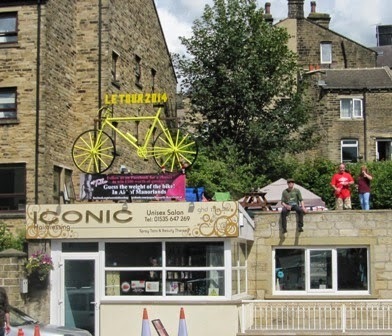
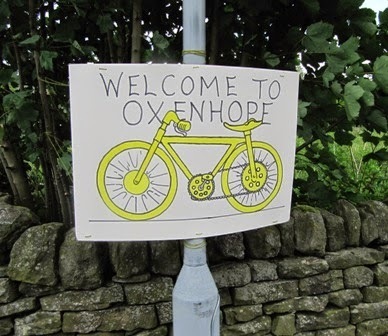 I decided to travel right to the end of the line, and even managed to glimpse the cycle race tearing by - the sheer speed they were going was staggering! On arriving at Oxenhope the first thing that struck me was the sheer number of flags, bunting and yellow coloured bicycles - they were just everywhere. As the race has just passed, everyone was spreading out picnics and lighting barbecues, and generally celebrating.
I decided to travel right to the end of the line, and even managed to glimpse the cycle race tearing by - the sheer speed they were going was staggering! On arriving at Oxenhope the first thing that struck me was the sheer number of flags, bunting and yellow coloured bicycles - they were just everywhere. As the race has just passed, everyone was spreading out picnics and lighting barbecues, and generally celebrating.
 Then it was back on the train to travel to Haworth, which had also really gone to town. I went into the lovely local park which was not only full of interesting stalls, live music and souvenirs of the race, but a huge screen had been set up and hundreds were settled down and were watching the race! How fortunate the weather was so outstanding, which made this a really lovely event.
Then it was back on the train to travel to Haworth, which had also really gone to town. I went into the lovely local park which was not only full of interesting stalls, live music and souvenirs of the race, but a huge screen had been set up and hundreds were settled down and were watching the race! How fortunate the weather was so outstanding, which made this a really lovely event.
Quite apart from all the bicycles which were absolutely everywhere, there were also a large number of red polka dots, which at the time rather puzzled me, but I discovered this on the web:
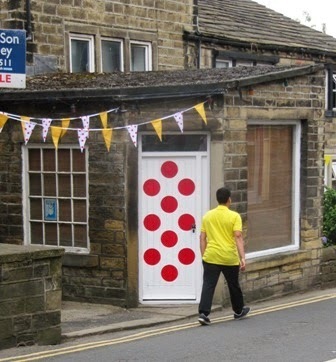 The polka dot jersey is given to the leader of the mountain classification in the Tour de France. Mountains in the Tour are categorized and the first few riders to make it to the summit of the tour are given a certain amount of points. The rider with the most points at the end of every stage is given the polka dot jersey.
The polka dot jersey is given to the leader of the mountain classification in the Tour de France. Mountains in the Tour are categorized and the first few riders to make it to the summit of the tour are given a certain amount of points. The rider with the most points at the end of every stage is given the polka dot jersey.
Then sadly it was time to leave this most beautiful part of the country and head back to crowded Haworth railway station, but what a grand day it had been, and whilst I might have only glimpsed the actual Race at least I can say 'I was there!'

***If you enjoy my writing why not click here

2014 is the first time this famous cycle race has gone through Yorkshire, and I wanted to be there! I wasn't particularly interested in the race itself - it was the 'Field of Vision' artworks created in the fields that interested me, and which I'd seen briefly on the TV programme 'Countryfile'. Unfortunately these proved totally inaccessible, which seemed to me rather a waste of time!
However, I did get to ride on the Worth steam train, which makes this wonderful 'chug, chug, chug' sound climbing up the hills! (See my previous blog about this train trip.)

 I decided to travel right to the end of the line, and even managed to glimpse the cycle race tearing by - the sheer speed they were going was staggering! On arriving at Oxenhope the first thing that struck me was the sheer number of flags, bunting and yellow coloured bicycles - they were just everywhere. As the race has just passed, everyone was spreading out picnics and lighting barbecues, and generally celebrating.
I decided to travel right to the end of the line, and even managed to glimpse the cycle race tearing by - the sheer speed they were going was staggering! On arriving at Oxenhope the first thing that struck me was the sheer number of flags, bunting and yellow coloured bicycles - they were just everywhere. As the race has just passed, everyone was spreading out picnics and lighting barbecues, and generally celebrating. Then it was back on the train to travel to Haworth, which had also really gone to town. I went into the lovely local park which was not only full of interesting stalls, live music and souvenirs of the race, but a huge screen had been set up and hundreds were settled down and were watching the race! How fortunate the weather was so outstanding, which made this a really lovely event.
Then it was back on the train to travel to Haworth, which had also really gone to town. I went into the lovely local park which was not only full of interesting stalls, live music and souvenirs of the race, but a huge screen had been set up and hundreds were settled down and were watching the race! How fortunate the weather was so outstanding, which made this a really lovely event.Quite apart from all the bicycles which were absolutely everywhere, there were also a large number of red polka dots, which at the time rather puzzled me, but I discovered this on the web:
 The polka dot jersey is given to the leader of the mountain classification in the Tour de France. Mountains in the Tour are categorized and the first few riders to make it to the summit of the tour are given a certain amount of points. The rider with the most points at the end of every stage is given the polka dot jersey.
The polka dot jersey is given to the leader of the mountain classification in the Tour de France. Mountains in the Tour are categorized and the first few riders to make it to the summit of the tour are given a certain amount of points. The rider with the most points at the end of every stage is given the polka dot jersey.Then sadly it was time to leave this most beautiful part of the country and head back to crowded Haworth railway station, but what a grand day it had been, and whilst I might have only glimpsed the actual Race at least I can say 'I was there!'

***If you enjoy my writing why not click here

Published on July 08, 2014 02:59
July 5, 2014
Live Music - Eyam Hall - Derbyshire
http://www.aboutnottinghamshire.co.uk/
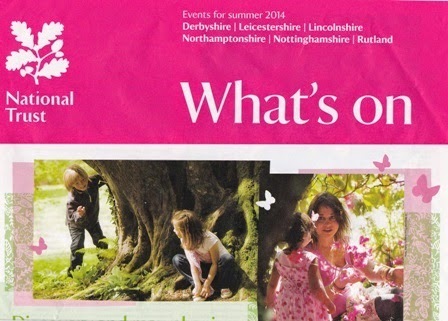 One of the big advantages of being a member of the National Trust is receiving their publication called 'What's On' which lists all the special events occurring in their properties in my area. I always go through it with a fine tooth-comb and discover all sorts of lovely things!
One of the big advantages of being a member of the National Trust is receiving their publication called 'What's On' which lists all the special events occurring in their properties in my area. I always go through it with a fine tooth-comb and discover all sorts of lovely things!
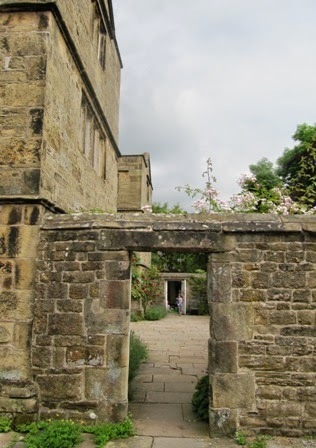 This quarter there was an evening event at Eyam Hall, the lovely Jacobean grit-stone Manor House in Derbyshire, built just six years after the terrible plague devastated the village. (see previous blog)
This quarter there was an evening event at Eyam Hall, the lovely Jacobean grit-stone Manor House in Derbyshire, built just six years after the terrible plague devastated the village. (see previous blog)
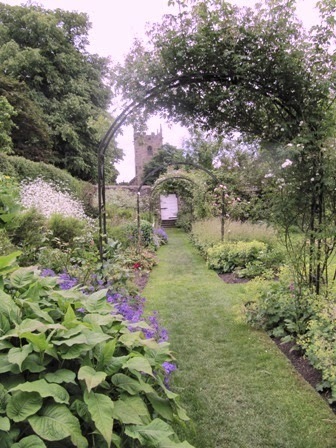 On my previous visit it had only been possible to see the garden by peering through the windows, but now it was possible to wander round this peaceful, atmospheric area, which is divided into several small areas. One of these had been set out for the children to use, and it was also the area where they told stories!
On my previous visit it had only been possible to see the garden by peering through the windows, but now it was possible to wander round this peaceful, atmospheric area, which is divided into several small areas. One of these had been set out for the children to use, and it was also the area where they told stories!
We had been encouraged to bring a picnic, and live music - which was absolutely excellent - was provided. What a wonderful way to spend a summer's evening - even though I could have done with it several degrees warmer!
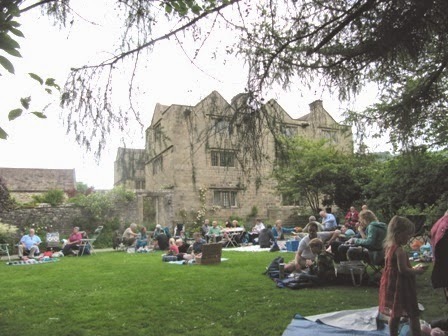 Just a few things I would have liked altered. Like it would have been nice to know who the excellent band was - and to have had a full introduction. Also notification of where the toilets were located - not everyone was local! - and more information about what was available refreshment-wise, and for how long, and how the evening was to be organized. Otherwise it was just brilliant.
Just a few things I would have liked altered. Like it would have been nice to know who the excellent band was - and to have had a full introduction. Also notification of where the toilets were located - not everyone was local! - and more information about what was available refreshment-wise, and for how long, and how the evening was to be organized. Otherwise it was just brilliant.
I really enjoyed this evening, and look forward to spotting other activities at this lovely place.
***
If you enjoy my writing why not see my Author's Page

 One of the big advantages of being a member of the National Trust is receiving their publication called 'What's On' which lists all the special events occurring in their properties in my area. I always go through it with a fine tooth-comb and discover all sorts of lovely things!
One of the big advantages of being a member of the National Trust is receiving their publication called 'What's On' which lists all the special events occurring in their properties in my area. I always go through it with a fine tooth-comb and discover all sorts of lovely things! This quarter there was an evening event at Eyam Hall, the lovely Jacobean grit-stone Manor House in Derbyshire, built just six years after the terrible plague devastated the village. (see previous blog)
This quarter there was an evening event at Eyam Hall, the lovely Jacobean grit-stone Manor House in Derbyshire, built just six years after the terrible plague devastated the village. (see previous blog) On my previous visit it had only been possible to see the garden by peering through the windows, but now it was possible to wander round this peaceful, atmospheric area, which is divided into several small areas. One of these had been set out for the children to use, and it was also the area where they told stories!
On my previous visit it had only been possible to see the garden by peering through the windows, but now it was possible to wander round this peaceful, atmospheric area, which is divided into several small areas. One of these had been set out for the children to use, and it was also the area where they told stories!We had been encouraged to bring a picnic, and live music - which was absolutely excellent - was provided. What a wonderful way to spend a summer's evening - even though I could have done with it several degrees warmer!
 Just a few things I would have liked altered. Like it would have been nice to know who the excellent band was - and to have had a full introduction. Also notification of where the toilets were located - not everyone was local! - and more information about what was available refreshment-wise, and for how long, and how the evening was to be organized. Otherwise it was just brilliant.
Just a few things I would have liked altered. Like it would have been nice to know who the excellent band was - and to have had a full introduction. Also notification of where the toilets were located - not everyone was local! - and more information about what was available refreshment-wise, and for how long, and how the evening was to be organized. Otherwise it was just brilliant.I really enjoyed this evening, and look forward to spotting other activities at this lovely place.
***
If you enjoy my writing why not see my Author's Page

Published on July 05, 2014 03:11
June 26, 2014
Welbeck Open Farm Weekend - Nottinghamshire
http://www.aboutnottinghamshire.co.uk/
It's always worth looking on the Open Farm Weekend website as there are always some really interesting places open to the public at this special time. This year I was amazed to find Welbeck listed for the first time. This is part of the Dukeries - the area to the north of Nottinghamshire where great junks of land were given to aristocrats in the past. Several of them are still very secret and private - and one of these is Welbeck - so the chance to actually get onto this estate was irresistible to me!
 The first thing that struck me was the organization. As soon as I parked, just off the A60, there was free transport laid on, up to the farm yard. This was full of fascinating stalls, food outlets etc. and we were also all given a really interesting booklet, which I'll keep as a souvenir. For me the most interesting thing was an big, old circle of wood, where each tree ring had been marked with a tag telling what had happened in that year. For example 'Florence Nightingale went to the Crimea' etc. It must have involved so much work, but the finished thing was absolutely fascinating and I could have studied it for ages.
The first thing that struck me was the organization. As soon as I parked, just off the A60, there was free transport laid on, up to the farm yard. This was full of fascinating stalls, food outlets etc. and we were also all given a really interesting booklet, which I'll keep as a souvenir. For me the most interesting thing was an big, old circle of wood, where each tree ring had been marked with a tag telling what had happened in that year. For example 'Florence Nightingale went to the Crimea' etc. It must have involved so much work, but the finished thing was absolutely fascinating and I could have studied it for ages.
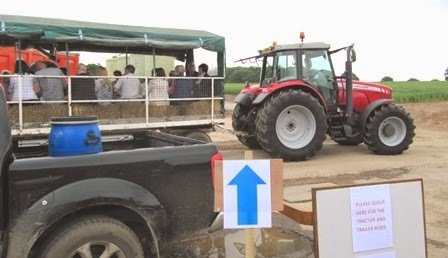 However, what I really wanted to do was go on a free tractor ride and see something of the estate! Clearly everyone else had the same idea, but there were several vehicles pulling the wagons so no-one had to wait too long. It was a very bumpy ride, but very interesting, made more so by an informative commentary, which is quite unusual on these occasions, but which makes it so much more interesting. Half way round we stopped to watch a hard-working team shearing the sheep.
However, what I really wanted to do was go on a free tractor ride and see something of the estate! Clearly everyone else had the same idea, but there were several vehicles pulling the wagons so no-one had to wait too long. It was a very bumpy ride, but very interesting, made more so by an informative commentary, which is quite unusual on these occasions, but which makes it so much more interesting. Half way round we stopped to watch a hard-working team shearing the sheep.
At last we even got a glimpse of the Abbey, which looked magnificent, and normally is never seen from this view!

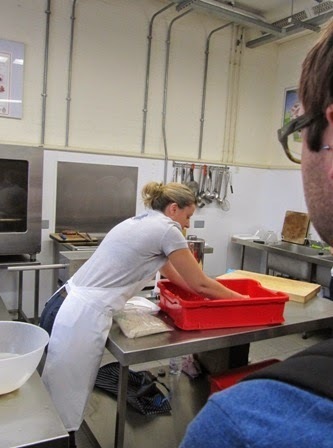 Then it was back to the farm to visit the School of Artisan Food and watch a sausage making demo. However, I think what I, and nearly everyone else, really wanted to do was to walk through one of the Duke's tunnels! The 5th Duke of Portland had a passion for tunnel-making, no-one is quite sure why, and they criss-cross the estate. Just one was open this particular weekend, and I couldn't wait to walk through The Grotto Tunnel with it's strange 'Pulhamite' walls which incorporated imitation fossils and strange petrified sea creatures. Just marvelous!
Then it was back to the farm to visit the School of Artisan Food and watch a sausage making demo. However, I think what I, and nearly everyone else, really wanted to do was to walk through one of the Duke's tunnels! The 5th Duke of Portland had a passion for tunnel-making, no-one is quite sure why, and they criss-cross the estate. Just one was open this particular weekend, and I couldn't wait to walk through The Grotto Tunnel with it's strange 'Pulhamite' walls which incorporated imitation fossils and strange petrified sea creatures. Just marvelous!
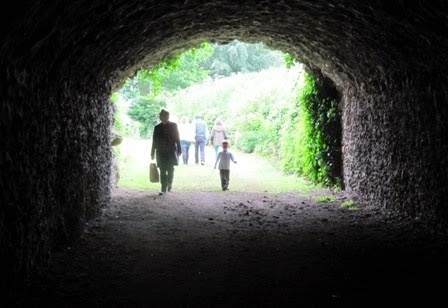
I thoroughly enjoyed this excellently arranged weekend, and can't wait to do it all again next year, and have more time to experience more of this unique place.

It's always worth looking on the Open Farm Weekend website as there are always some really interesting places open to the public at this special time. This year I was amazed to find Welbeck listed for the first time. This is part of the Dukeries - the area to the north of Nottinghamshire where great junks of land were given to aristocrats in the past. Several of them are still very secret and private - and one of these is Welbeck - so the chance to actually get onto this estate was irresistible to me!
 The first thing that struck me was the organization. As soon as I parked, just off the A60, there was free transport laid on, up to the farm yard. This was full of fascinating stalls, food outlets etc. and we were also all given a really interesting booklet, which I'll keep as a souvenir. For me the most interesting thing was an big, old circle of wood, where each tree ring had been marked with a tag telling what had happened in that year. For example 'Florence Nightingale went to the Crimea' etc. It must have involved so much work, but the finished thing was absolutely fascinating and I could have studied it for ages.
The first thing that struck me was the organization. As soon as I parked, just off the A60, there was free transport laid on, up to the farm yard. This was full of fascinating stalls, food outlets etc. and we were also all given a really interesting booklet, which I'll keep as a souvenir. For me the most interesting thing was an big, old circle of wood, where each tree ring had been marked with a tag telling what had happened in that year. For example 'Florence Nightingale went to the Crimea' etc. It must have involved so much work, but the finished thing was absolutely fascinating and I could have studied it for ages. However, what I really wanted to do was go on a free tractor ride and see something of the estate! Clearly everyone else had the same idea, but there were several vehicles pulling the wagons so no-one had to wait too long. It was a very bumpy ride, but very interesting, made more so by an informative commentary, which is quite unusual on these occasions, but which makes it so much more interesting. Half way round we stopped to watch a hard-working team shearing the sheep.
However, what I really wanted to do was go on a free tractor ride and see something of the estate! Clearly everyone else had the same idea, but there were several vehicles pulling the wagons so no-one had to wait too long. It was a very bumpy ride, but very interesting, made more so by an informative commentary, which is quite unusual on these occasions, but which makes it so much more interesting. Half way round we stopped to watch a hard-working team shearing the sheep.At last we even got a glimpse of the Abbey, which looked magnificent, and normally is never seen from this view!

 Then it was back to the farm to visit the School of Artisan Food and watch a sausage making demo. However, I think what I, and nearly everyone else, really wanted to do was to walk through one of the Duke's tunnels! The 5th Duke of Portland had a passion for tunnel-making, no-one is quite sure why, and they criss-cross the estate. Just one was open this particular weekend, and I couldn't wait to walk through The Grotto Tunnel with it's strange 'Pulhamite' walls which incorporated imitation fossils and strange petrified sea creatures. Just marvelous!
Then it was back to the farm to visit the School of Artisan Food and watch a sausage making demo. However, I think what I, and nearly everyone else, really wanted to do was to walk through one of the Duke's tunnels! The 5th Duke of Portland had a passion for tunnel-making, no-one is quite sure why, and they criss-cross the estate. Just one was open this particular weekend, and I couldn't wait to walk through The Grotto Tunnel with it's strange 'Pulhamite' walls which incorporated imitation fossils and strange petrified sea creatures. Just marvelous!
I thoroughly enjoyed this excellently arranged weekend, and can't wait to do it all again next year, and have more time to experience more of this unique place.

Published on June 26, 2014 23:51
June 23, 2014
Royal College of Physians' Medicinal Garden - Open Squares weekend - London
http://www.aboutnottinghamshire.co.uk/
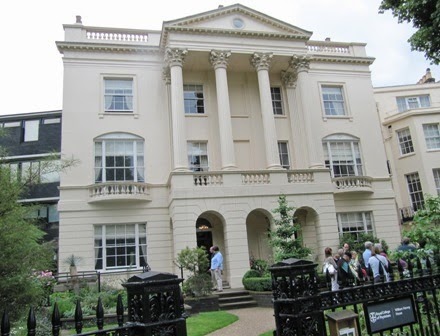 As I explained in my previous blog this was the first time I had attended this marvellous weekend. My second garden was at the Royal College of Physicians, which was founded in 1518 by a charter from Henry VIII.
As I explained in my previous blog this was the first time I had attended this marvellous weekend. My second garden was at the Royal College of Physicians, which was founded in 1518 by a charter from Henry VIII.
The garden is unique in that almost every one of the 1100 species of plant here has a link to medicine, whether in folk tradition, as a raw material, or chemical model, needed to produce a pharmaceutical drug. A fibre plant may even have been used to make bandages.
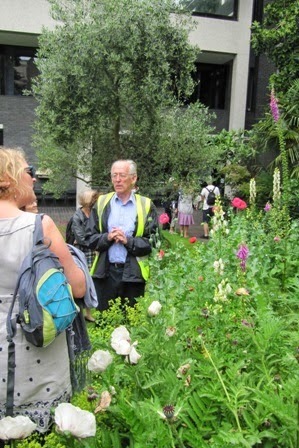 I was fortunate enough to join a tour taken by Dr. Henry Oakeley, and what a delight he proved to be! Clearly extremely intelligent and intellectual, he still aimed the talk so there was something for everyone to understand, and certainly had the large group engrossed for more than an hour.
I was fortunate enough to join a tour taken by Dr. Henry Oakeley, and what a delight he proved to be! Clearly extremely intelligent and intellectual, he still aimed the talk so there was something for everyone to understand, and certainly had the large group engrossed for more than an hour.
 A typical example was in the case of the foxglove. Dr Oakeley told us that the woolly variety, Digitalis lanata has a strange effect on the many bees that visit the bell-like flowers. The bees become completely 'stoned' and can be tapped out of the flowers, when they lie comatose, usually upside down. If disturbed they buzz gently, before dropping asleep once more. When recovered they will fly off to find the next foxglove - and repeat the process all over again - somewhat like medical students Dr Oakeley said, which made us all laugh.
A typical example was in the case of the foxglove. Dr Oakeley told us that the woolly variety, Digitalis lanata has a strange effect on the many bees that visit the bell-like flowers. The bees become completely 'stoned' and can be tapped out of the flowers, when they lie comatose, usually upside down. If disturbed they buzz gently, before dropping asleep once more. When recovered they will fly off to find the next foxglove - and repeat the process all over again - somewhat like medical students Dr Oakeley said, which made us all laugh.
The foxglove is the source of the cardiac medicine digoxin.
After this fascinating talk, there was only time for a quick cup of tea, and a visit to a room containing the amazing collection amassed by Cecil Symons (1921 -1987) who was a physician and cardiologist at the Royal Free Hospital. His interest in self-care in the Georgian era led him to begin this collection.
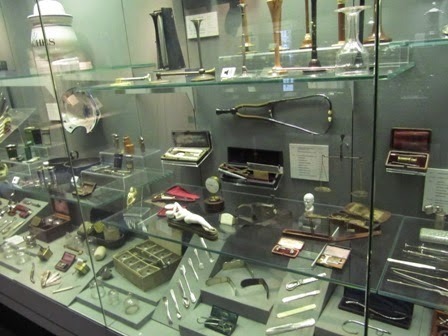 Now I know about this amazing annual event I can't wait til next year to discover more amazing gardens hidden in the middle of London.
Now I know about this amazing annual event I can't wait til next year to discover more amazing gardens hidden in the middle of London.

 As I explained in my previous blog this was the first time I had attended this marvellous weekend. My second garden was at the Royal College of Physicians, which was founded in 1518 by a charter from Henry VIII.
As I explained in my previous blog this was the first time I had attended this marvellous weekend. My second garden was at the Royal College of Physicians, which was founded in 1518 by a charter from Henry VIII. The garden is unique in that almost every one of the 1100 species of plant here has a link to medicine, whether in folk tradition, as a raw material, or chemical model, needed to produce a pharmaceutical drug. A fibre plant may even have been used to make bandages.
 I was fortunate enough to join a tour taken by Dr. Henry Oakeley, and what a delight he proved to be! Clearly extremely intelligent and intellectual, he still aimed the talk so there was something for everyone to understand, and certainly had the large group engrossed for more than an hour.
I was fortunate enough to join a tour taken by Dr. Henry Oakeley, and what a delight he proved to be! Clearly extremely intelligent and intellectual, he still aimed the talk so there was something for everyone to understand, and certainly had the large group engrossed for more than an hour. A typical example was in the case of the foxglove. Dr Oakeley told us that the woolly variety, Digitalis lanata has a strange effect on the many bees that visit the bell-like flowers. The bees become completely 'stoned' and can be tapped out of the flowers, when they lie comatose, usually upside down. If disturbed they buzz gently, before dropping asleep once more. When recovered they will fly off to find the next foxglove - and repeat the process all over again - somewhat like medical students Dr Oakeley said, which made us all laugh.
A typical example was in the case of the foxglove. Dr Oakeley told us that the woolly variety, Digitalis lanata has a strange effect on the many bees that visit the bell-like flowers. The bees become completely 'stoned' and can be tapped out of the flowers, when they lie comatose, usually upside down. If disturbed they buzz gently, before dropping asleep once more. When recovered they will fly off to find the next foxglove - and repeat the process all over again - somewhat like medical students Dr Oakeley said, which made us all laugh.The foxglove is the source of the cardiac medicine digoxin.
After this fascinating talk, there was only time for a quick cup of tea, and a visit to a room containing the amazing collection amassed by Cecil Symons (1921 -1987) who was a physician and cardiologist at the Royal Free Hospital. His interest in self-care in the Georgian era led him to begin this collection.
 Now I know about this amazing annual event I can't wait til next year to discover more amazing gardens hidden in the middle of London.
Now I know about this amazing annual event I can't wait til next year to discover more amazing gardens hidden in the middle of London.
Published on June 23, 2014 06:14
June 16, 2014
Park Square - Open Garden Squares Weekend - London
http://www.aboutnottinghamshire.co.uk/

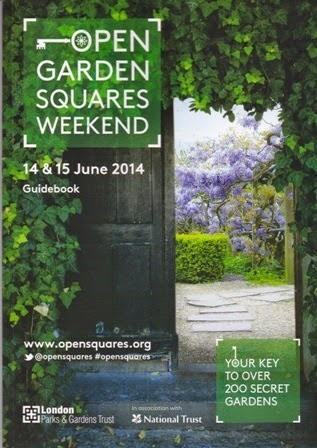 I just can't believe I've only recently discovered this amazing event. Apparently for the last 20 years the London Parks & Gardens Trust have been holding an Open Gardens Squares Weekend. As anyone who has ever been to London will know, many of the more exclusive areas are built round a park-like space in the middle, which is for the private use of the residents, and they understandably guard their exclusivity - after all these properties are the most expensive in the land.
I just can't believe I've only recently discovered this amazing event. Apparently for the last 20 years the London Parks & Gardens Trust have been holding an Open Gardens Squares Weekend. As anyone who has ever been to London will know, many of the more exclusive areas are built round a park-like space in the middle, which is for the private use of the residents, and they understandably guard their exclusivity - after all these properties are the most expensive in the land.
However, for this one precious weekend many are open to ticket holders. The first delight was the arrival of this information-packed book containing details of all 219 gardens - in fact the amount of information was quite overwhelming.
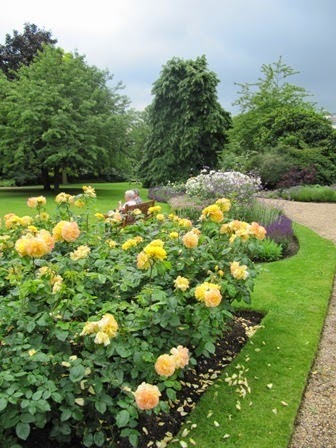 However, I decided, eventually, to visit Park Square which is the largest of London's private squares, just off Regent's Park. You arrive at the entrance gate by walking down Park Square East, where on one side are lovely John Nash houses, one of which I noticed was the home for The Prince's Trust. Inside is an oasis of calm, and the beautifully kept flower beds were full of gloriously scented roses. There were also a number of plane trees said to have been planted in 1817 to commemorate the victory at Waterloo two years earlier.
However, I decided, eventually, to visit Park Square which is the largest of London's private squares, just off Regent's Park. You arrive at the entrance gate by walking down Park Square East, where on one side are lovely John Nash houses, one of which I noticed was the home for The Prince's Trust. Inside is an oasis of calm, and the beautifully kept flower beds were full of gloriously scented roses. There were also a number of plane trees said to have been planted in 1817 to commemorate the victory at Waterloo two years earlier.
Originally it had been created as one large garden, but then the busy Marylebone Road was constructed, and this unique construction was created, which fascinated me. Known as the 'Nursemaids' Tunnel', it was built after a petition by residents in July 1821 for a 'subterraneous communication be made between the two gardens so as to obviate the necessity of crossing the New Road, a matter of considerable danger at most times to children and of inconvenience to ladies who are desirous of going from the garden to the other'.
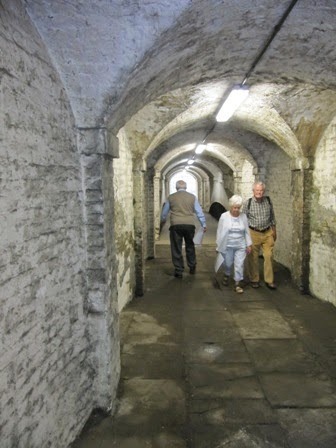
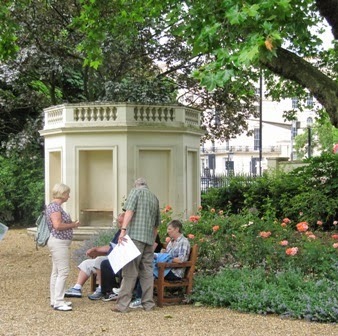 The tunnel came under threat in the 1850's when the Metropolitan Railways started to build London's first underground line with the section between King's Cross and Paddington. Its route would have destroyed the pedestrian tunnel, but it was protected by the North Metropolitan Railway Act of 1854.
The tunnel came under threat in the 1850's when the Metropolitan Railways started to build London's first underground line with the section between King's Cross and Paddington. Its route would have destroyed the pedestrian tunnel, but it was protected by the North Metropolitan Railway Act of 1854.
There are two ornamental ventilation shafts for the Bakerloo line in Park Crescent, the area at the end of the tunnel.
I thought this an absolutely amazing experience, and wouldn't have missed it for anything.
I'm just sorry that I now have to wait a year before visiting more of these very special places.


 I just can't believe I've only recently discovered this amazing event. Apparently for the last 20 years the London Parks & Gardens Trust have been holding an Open Gardens Squares Weekend. As anyone who has ever been to London will know, many of the more exclusive areas are built round a park-like space in the middle, which is for the private use of the residents, and they understandably guard their exclusivity - after all these properties are the most expensive in the land.
I just can't believe I've only recently discovered this amazing event. Apparently for the last 20 years the London Parks & Gardens Trust have been holding an Open Gardens Squares Weekend. As anyone who has ever been to London will know, many of the more exclusive areas are built round a park-like space in the middle, which is for the private use of the residents, and they understandably guard their exclusivity - after all these properties are the most expensive in the land.However, for this one precious weekend many are open to ticket holders. The first delight was the arrival of this information-packed book containing details of all 219 gardens - in fact the amount of information was quite overwhelming.
 However, I decided, eventually, to visit Park Square which is the largest of London's private squares, just off Regent's Park. You arrive at the entrance gate by walking down Park Square East, where on one side are lovely John Nash houses, one of which I noticed was the home for The Prince's Trust. Inside is an oasis of calm, and the beautifully kept flower beds were full of gloriously scented roses. There were also a number of plane trees said to have been planted in 1817 to commemorate the victory at Waterloo two years earlier.
However, I decided, eventually, to visit Park Square which is the largest of London's private squares, just off Regent's Park. You arrive at the entrance gate by walking down Park Square East, where on one side are lovely John Nash houses, one of which I noticed was the home for The Prince's Trust. Inside is an oasis of calm, and the beautifully kept flower beds were full of gloriously scented roses. There were also a number of plane trees said to have been planted in 1817 to commemorate the victory at Waterloo two years earlier.Originally it had been created as one large garden, but then the busy Marylebone Road was constructed, and this unique construction was created, which fascinated me. Known as the 'Nursemaids' Tunnel', it was built after a petition by residents in July 1821 for a 'subterraneous communication be made between the two gardens so as to obviate the necessity of crossing the New Road, a matter of considerable danger at most times to children and of inconvenience to ladies who are desirous of going from the garden to the other'.

 The tunnel came under threat in the 1850's when the Metropolitan Railways started to build London's first underground line with the section between King's Cross and Paddington. Its route would have destroyed the pedestrian tunnel, but it was protected by the North Metropolitan Railway Act of 1854.
The tunnel came under threat in the 1850's when the Metropolitan Railways started to build London's first underground line with the section between King's Cross and Paddington. Its route would have destroyed the pedestrian tunnel, but it was protected by the North Metropolitan Railway Act of 1854.There are two ornamental ventilation shafts for the Bakerloo line in Park Crescent, the area at the end of the tunnel.
I thought this an absolutely amazing experience, and wouldn't have missed it for anything.
I'm just sorry that I now have to wait a year before visiting more of these very special places.

Published on June 16, 2014 06:07



